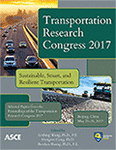Transportation Research Congress 2017
Research on New Component Analysis Method for Pyrolytic Crumb Rubber Modified Asphalt
Publication: Transportation Research Congress 2017: Sustainable, Smart, and Resilient Transportation
ABSTRACT
On the basis of the problems in analyzing the components of pyrolytic crumb rubber modified asphalt (PRA) by the current component analysis method, a new method applicable to component analysis of PRA was proposed through material characteristics analysis of PRA and solubility test of rubber hydrocarbon. Components of PRA were divided into petroleum ether soluble fraction, toluene soluble fraction, and insoluble fraction. The matching formulas were put forward and the operation of the experiment was simplified. The new method was used to analyze the components of PRA made by pyrolysis at 250°C for 0 min, 30 min, 60 min, 120 min, 240 min, and 480 min respectively. And the content of maltenes, asphaltenes, and base asphalt in PRA was obtained by the formulas. The pyrolysis mechanism of PRA was well explained by the composition change rules of PRA. The content of base asphalt in PRA increased from 70% to 91.25% at 60 min pyrolysis, and the conversion of the crumb rubber powder to the asphalt was realized.
Get full access to this article
View all available purchase options and get full access to this chapter.
ACKNOWLEDGMENT
This study was supported by National International S&T Cooperation Program-funded Project (No. 2013DFR50550) and National Natural Science Foundation of China (No. 51578097).
REFERENCES
1.
Lv Quan, Huang Weidong, Chai Chongchong. Properties and Application of Terminal Blending Rubber Asphalt [J]. Journal of Chongqing Jiaotong University (Natural Science), 2014, 33(4):51-55.
2.
Billiter, T C, Davison, R R, Glover, J.A. & Bullin, C J. Physical properties of asphalt-rubber binder [J]. Petroleum Science and Technology, 2007, 15(3): 205-236.
3.
Huang, Weidong, Zheng, Mao, Huang, Ming. Fatigue performance of Terminal Blend Rubberized asphalt micture[J]. Journal of Tongji University (Natural Science), 2014, 42(10):1543-1549.
4.
Dong Ruikun, Zheng Mao, Huang, Weidong, Huang, Ming. Fatigue performance comparison of various kinds of asphalt mixtures with Self-healing compensation considered [J]. China Journal of Highway and Transport, 2015, 28(5); 87-92.
5.
Hajj, E Y, Sebaaly, P E, Hitti, E, et al. Performance Evaluation of Terminal Blend Tire Rubber HMA and WMA Mixtures-Case Studies[J]. Asphalt Paving Technology, 2011, 80(4):pags. 665-696.
6.
Presti, D L, Airey, G, Partal, P. Manufacturing Terminal and Field Bitumen-Tyre Rubber Blends: The Importance of Processing Conditions[J]. Procedia - Social and Behavioral Sciences, 2012, 53(53): 485-494.
7.
Michalica, P, Kazatchkov, I B, Stastna, J, et al. Relationship between chemical and rheological properties of two asphalts of different origins [J]. Fuel, 2008, 87(15):3247-3253.
8.
Didier Lesueur. The colloidal structure of bitumen: Consequences on the rheology andon the mechanisms of bitumen modification. Advances in Colloid and Interface Science, 2009, 145(1-2): 42-82.
9.
Transport Ministry of the People 's Republic of China. JTG E20-2011 Highway Engineering Asphalt and Asphalt Mixture Test Code [S]. Beijing: People's Communications Press, 2011.
10.
Jing, Yanping. Analysis of Asphalt Component Division [J]. Journal of Chang'an University Natural Science Edition, 2005, 25(3): 33-36.
11.
Liu, Meihua, Fan, Yaohua. Effects of Alumina Activity on Separation of Petroleum Asphalt by Four Component Separation [J]. Petroleum Pitch, 1994 (2): 1-5.
12.
Ramarad, S, Khalid, M, Ratnam, C T, et al. Waste tire rubber in polymer blends: A review on the evolution, properties and future[J]. Progress in Materials Science, 2015, 72:100-140.
13.
Zhang, Xiaoying. Study on Desulfurization Degradation of Waste Rubber Powder-Asphalt System [D]. Petroleum University (East China) China University of Petroleum (East China), 2002.
14.
Larsen, D O, Alessandrini, J L, Bosch, A, et al. Micro-structural and rheological characteristics of SBS-asphalt blends during their manufacturing[J]. Construction & Building Materials, 2009, 23(8): 2769-2774.
15.
Yalçiner, A, Güzelgöz, M M, Çýmenoðlu, M. Akif, et al. Dynamic Nuclear Polarization in Suspensions of Asphaltenes Obtained from Asphalt Cements[J]. Turkish Journal of Physics, 1996, 20(2):135-145.
16.
Zanzotto, L, Kennepohl, G. Development of Rubber and Asphalt Binders by Depolymerization and Devulcanization of Scrap Tires in Asphalt[J]. Transportation Research Record, 1996, (1):51-58.
Information & Authors
Information
Published In
Transportation Research Congress 2017: Sustainable, Smart, and Resilient Transportation
Pages: 189 - 196
Editors: Linbing Wang, Ph.D., Virginia Polytechnic University, Hongren Gong, Ph.D., University of Tennessee, Knoxville, and Baoshan Huang, Ph.D., University of Tennessee, Knoxville
ISBN (Online): 978-0-7844-8251-3
Copyright
© 2019 American Society of Civil Engineers.
History
Published online: Oct 3, 2019
Published in print: Oct 3, 2019
Authors
Metrics & Citations
Metrics
Citations
Download citation
If you have the appropriate software installed, you can download article citation data to the citation manager of your choice. Simply select your manager software from the list below and click Download.
